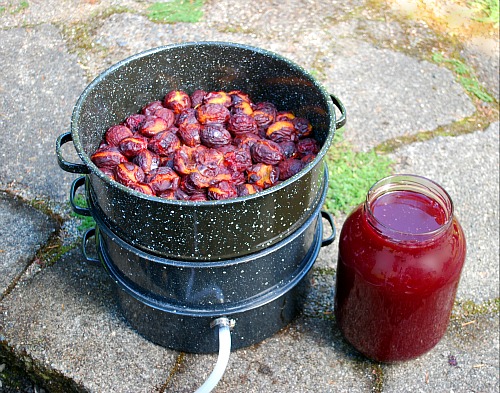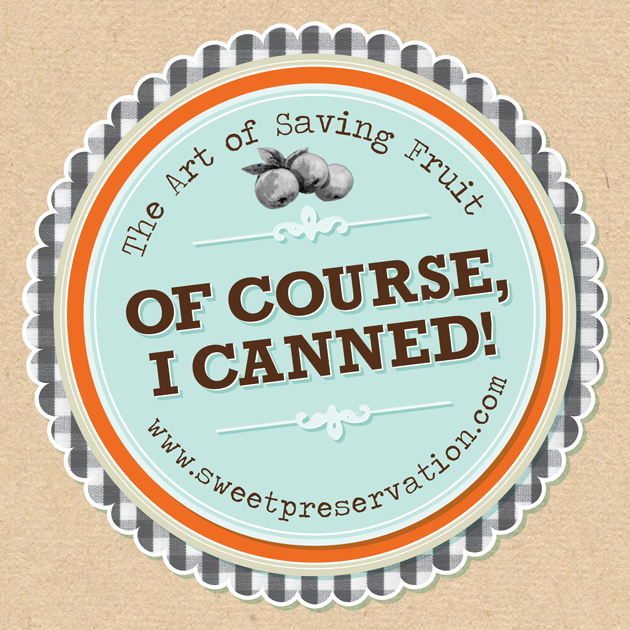Perfect Plum Jelly using the Steam Juice Extractor
 Sunday, September 25, 2011 at 1:13PM
Sunday, September 25, 2011 at 1:13PM My friend Mary brought me a big plastic tub full of plums from her neighbors' tree and they sure are delicious. Even my little Pug ShuMai couldn't resist their heady scent.

I moment I bit into the first plum I realized they were perfect. Freestones, the right amount of ripeness, full of flavor, and no bitter skins. I have so many of them I've decided to use them several ways. The first thing I did today was extract juice to make jelly. I also have plans to make Sugar Plums, Plum~Lemon Verbena Jam, and Plum Cordial.
Since these are freestone-type plums, the pits are easy to remove and they're a real pleasure to cook with. Even so, one thing that can be done to preserve plums without pitting them is to run them through a steam juice extractor.

I didn't weigh the plums, but the top portion holds about 20 pounds, which yielded exactly one gallon of juice after about one hour in my funky vintage steam juice extractor.

I cooked half of the juice with sugar...

...and lemon juice...

...and boiled it like crazy....

...which turned it into jelly.

And saved the rest of the juice for a second batch using added pectin*, so I can compare both batches of Plum Jelly side-by-side.

Perfect Plum Jelly (without using pectin)
Plum Jelly (with added pectin)
*To get you started, here's some immensely helpful info about making jams and jellies with or without added pectin, thanks to the University of Missouri Extension.









Reader Comments (4)
Beautiful! I've never used a steam extractor and this makes me want to run out and buy one. Is there anything you can do with the plums once the juice has been extracted?
You know Diana, I think it depends on the fruit. I've had people tell me that you can make fruit leather with the pulp, but sometimes the leftover pulp doesn't have a lot of flavor.
I did a post about using the Steam Juice Extractor to make Apricot Nectar. In that instance, I extracted the (almost clear) apricot juice, then ran the apricot pulp through a food mill, and then mixed the two together, with sugar, to make the apricot nectar.
When I used the SJE to make sour cherry juice (which I turned into jelly) that sour cherry pulp didn't have any flavor at all. It tasted like "nothing"!
So maybe if you start with a naturally sweet fruit, like apricots or sweet cherries, you can make fruit leather, but the sour cherry pulp didn't taste good enough to save, nor did the plum pulp. (The worms in my compost bin are probably loving it right about now.)
Does this make sense?
I hope so.
Thank you for reading my blog :)
Thanks, Brook, for your response. I went and looked at your apricot nectar recipe and I have (another) question. It looks like you canned the nectar, or did you just put it in canning jars and store it in the fridge? I ask because I didn't see any lemon juice added and I wondered if it was safe to can it. It looks so delicious that it may not have lasted long enough to even bother processing it!
Hi Diana,
I just added a comment about adding lemon juice to the nectar to my Apricot Nectar blog post. If I had created a link to the recipe, like I often do if I have the extra time to type everything up, I would have mentioned that I added a bit of lemon juice, but nowhere near the 1 tablespoon per quart that some canning guides suggest as an option when bottling & processing it.
It is delicious! I gave away a few jars to people who just chilled it and drank it right away (or used it in recipes.) If I had space in the fridge and/or had made less, I wouldn't have bothered processing it. It is plenty acidic, but of course that varies quite a bit depending on the apricots, their ripeness, etc. Thanks!